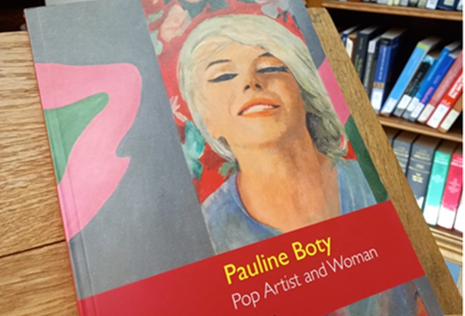Pauline Boty: a forgotten icon of the British Pop Art movement
Amelia Platt delves into life and works of Pauline Boty, whose art pushed boundaries and subverted expectations of women in the Sixties

In the 1966 film Alfie, the titular character played by Michael Caine kisses a smiling, blonde woman in a launderette. Though she is only on the screen for minutes, her joyful exuberance shines through. The woman in question is Pauline Boty.
Born in 1938, Boty was a founding member of the British Pop Art movement, and one of the few female painters involved. Despite its low admission rates for women, Boty studied at the Royal College of Art and became friends with other emerging talents like Peter Blake and David Hockney. Boty’s impact was greatly significant, and yet today few people know of her. She was often defined by two factors: her mesmerising beauty and tragic death from cancer at the age of twenty-eight. From today’s perspective, she appears to be the perfect embodiment of the swinging sixties.
“Boty’s work resists easy explanations – complexity is always central to them”
One of my favourite works by Boty is titled The Only Blonde in the World, (1963), depicting Marilyn Monroe. In the oil painting, abstract patterned green seems to slide away to reveal Marilyn, striding forward with purposeful movement. She is instantly recognizable with her vivacious smile and peroxide blonde hair. As our eyes travel down, the brushstrokes become untidier and more frantic. Marilyn seems to move within the picture, swinging her hips side to side as she walks, tassels on her silver dress swaying. Suddenly, the green on either side seems a little oppressive. Is it sliding away from Marilyn or towards her? Perhaps it is the lens of a camera, framing Monroe before taking the shot. Boty felt a great affinity for Monroe and was devastated by her death. The painting exists as a fitting posthumous tribute, capturing the vivacity, which was Monroe’s appeal, while at the same time remaining fixed at a distance. We cannot ultimately access Marilyn. Boty’s work resists easy explanations – complexity is always central to them. They celebrate but also criticise.
Like Monroe, Boty struggled with being defined completely by her appearance. This is encapsulated by a 1962 article about her, which read: “Actresses often have tiny brains. Painters often have large beards. Imagine a brainy actress who is also a painter and a blonde and you have Pauline Boty.” Boty pushed against the fixed and narrow parameters of her time, subverting expectations of what female artists could do. Her work was defiant in its focus on sexuality, use of humorous imagery and bright colours, despite these elements being dismissed as ‘girlish.’ Through her art, Boty gave the female body its autonomy back, often posing with her paintings. In one photo, the canvas replaces her body, with only Boty’s head and feet visible. Despite her efforts, the endless stereotyping did take its toll, contributing to her experiences of depression in later life. Ironically, her focus on the female body was also overlooked and misunderstood by some feminist art historians in the 70s, who criticised her art for portraying women in a ‘sexualised’ way.
“After her death, her paintings were gathered up, stored, and promptly forgotten about”
Boty was fascinated with both the high and low cultures of news, pop and film, and the ways that they were intertwined. Speaking on the subject she said, “Film stars are the 20th-century gods and goddesses. People need them, and the myths that surround them, because their own lives are enriched by them. Pop art colours those myths.”
Despite all the glamour and excitement, the Sixties were undoubtedly a period of conflict and inequality. This became central to Boty’s later work, influenced too by her movement within activist circles. For instance, in It’s a Man's World Boty creates a collage of men including politicians, scientists, great thinkers, and icons of the music and sporting world. Round the outside of the painting are images of violence – a fighter jet, the assassination of JFK. In the centre lies a red rose, a recurring motif in Boty’s work symbolic of feminine desire and sexuality. Yet here the rose has been cropped to fit within a square. The previously irrepressible symbol of femininity has an added vulnerability. The pressures of conforming to a masculine world are beginning to show.
Boty’s work has recently experienced greater recognition, with solo retrospective exhibitions having been held and a biography published. After her death, her paintings were gathered up, stored, and promptly forgotten about, left abandoned in a barn in Kent belonging to one of her brothers. These were rediscovered in the 1990s by David Alan Mellor, Professor of Art at Sussex University. However, the whereabouts of three of Boty’s major works including Scandal 63 remain unknown. In the 1966 Alfie film, Boty’s role as the laundress was uncredited. To this day, I would argue, her role in the art world is mostly still uncredited too.
 News / Eight Cambridge researchers awarded €17m in ERC research grants27 December 2025
News / Eight Cambridge researchers awarded €17m in ERC research grants27 December 2025 News / News in Brief: carols, card games, and canine calamities28 December 2025
News / News in Brief: carols, card games, and canine calamities28 December 2025 News / Caius mourns its tree-mendous loss23 December 2025
News / Caius mourns its tree-mendous loss23 December 2025 News / Clare Hall spent over £500k opposing busway 24 December 2025
News / Clare Hall spent over £500k opposing busway 24 December 2025 Interviews / Meet Juan Michel, Cambridge’s multilingual musician29 December 2025
Interviews / Meet Juan Michel, Cambridge’s multilingual musician29 December 2025









